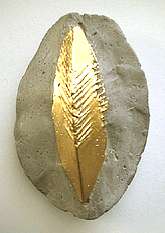As an antidote to that technological bog, I often use modelling clay as a quick mold. I use Plasticene®, but any oil-based modelling clay works. You can work directly in the material with rubber stamps, carving tools, or even your fingers. It's a relaxing creative process with no worries about making mistakes - just roll out some more and try again. I work with two hardnesses of modelling clay. For example, if I wanted letters to be raised on the surface of a final concrete piece, I would use rubber stamp letters (like the kind you find in children's printing sets) pressed into a flat sheet of the harder Plasticene, dust it with talcum powder, then press the softer clay into that mold. When pulled apart, this softer clay now becomes the mold for the final concrete. You have to be careful placing the concrete into the soft mold as the surface is easily marred.
 In this concrete pin, I created a simple mold from modelling clay, by pressing a ridged form into the soft clay, texturing the negative space with lines, then cast concrete into it. Later I applied gold leaf.
In this concrete pin, I created a simple mold from modelling clay, by pressing a ridged form into the soft clay, texturing the negative space with lines, then cast concrete into it. Later I applied gold leaf.
No comments:
Post a Comment